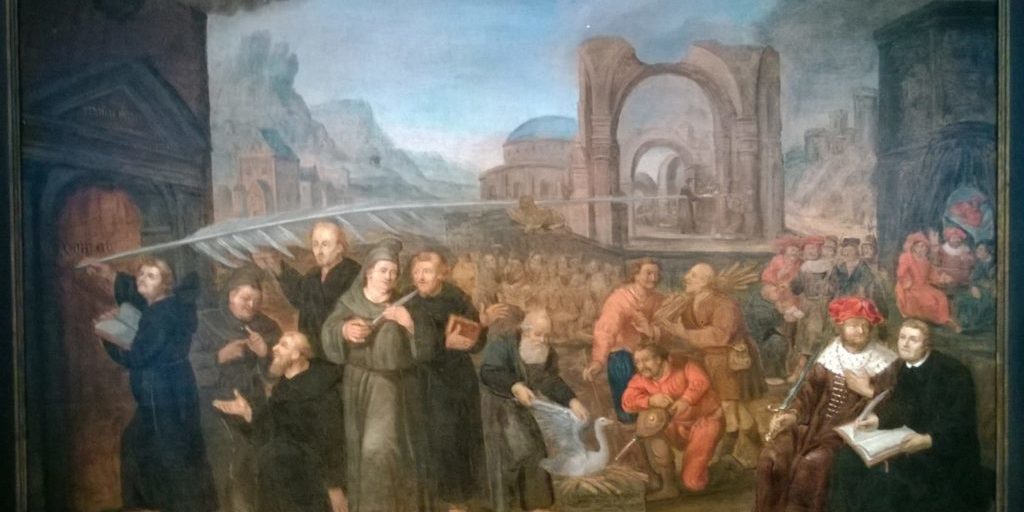
An Invitation to the Heidelberg Catechism: Part One
Hey fellow sinners! How do you know you are SAVED? Why do you believe what you SAY you believe? Tragically many Christians… do not have a clue as to WHY they believe it from the Holy Scriptures…. If you will study this inspiring little volume in one hand with your Bible in the other, you will know why you believe what you say you believe…. I commend this historic volume to you knowing the body of Christ will be stronger and better equipped to build the Kingdom together!
I  had been a Christian all of two years. I was disillusioned by my Pentecostal experience. Then I heard the Heidelberg Catechism mentioned on the White Horse Inn, and I had to find a copy. I checked the college bookstore; no luck. I went to Calvary Chapel Costa Mesa’s bookstore; no way Jose! Then I found a Christian bookstore with a large used section. I wandered around, scanned dozens upon dozens of shelves. Eureka!
had been a Christian all of two years. I was disillusioned by my Pentecostal experience. Then I heard the Heidelberg Catechism mentioned on the White Horse Inn, and I had to find a copy. I checked the college bookstore; no luck. I went to Calvary Chapel Costa Mesa’s bookstore; no way Jose! Then I found a Christian bookstore with a large used section. I wandered around, scanned dozens upon dozens of shelves. Eureka!
I was a 19-year old, disillusioned, Pentecostal college student searching out a 400-year old catechism. I opened it, read the above Foreward, and noticed the words came from Paul Crouch of the Trinity Broadcasting Network! This couldn’t be right. A Word of Faith preacher recommending the catechism I heard on the White Horse Inn? Amazingly, it’s true.
I still have that little paperback on my shelf to remind me “I once was lost, but now am found.” I want to invite you to take up this Heidelberg Catechism so that you’ll discover its joys and treasures for yourself.
Highlights of the Heidelberg: The Who, What, When, Where, & Why
When was the Heidelberg Catechism published? January 19, 1563. That’s only 90 years since the final fall of the Roman Empire at Constantinople to the Ottoman Turks; 46 years since Martin Luther nailed his Ninety-Five Theses; 37 years since William Tyndale published his New Testament; 34 years since the Ottomans were seen at the gates of Vienna; 4 years since the final edition of John Calvin’s Institutes, and just 1 month since the Council of Trent came to an end. It had been a turbulent century and even decade.
Where was it written and published? In Heidelberg, capital city of the Palatinate. This was a German-speaking region within the Holy Roman Empire. Its roots were ancient, being mentioned as far back as the 6th century during the time of the Frankish King, Childebert I.
The roots of catechisms come from Old Testament creeds and confessions like the Shema (Deut. 6:4) and the New Testament’s “Christ is Lord!” Click To Tweet By 1546 Protestantism was the religion of the realm. Yet Charles V, Holy Roman Emperor, crushed the Protestants in 1547 at the Battle of Mühlberg, and the Augsburg Interim re-introduced Roman practice with minor concessions of communion in both kinds and clerical marriage. The 1555 Peace of Augsburg granted secular princes the right to determine their realms’ religion between Lutheranism and Catholicism. In 1556 Otto Heinrich began to reign as an enthusiastic Lutheran. Yet by adding professors of various theological stripes to Heidelberg University, he caused factions between strict Lutherans, Melanchthonian Lutherans, and Zurich-minded Reformed men. Otto died and his successor, Frederick III, sponsored a Disputation from June 3–7, 1560 on the mode of Christ’s presence at the Lord’s Supper leading to him supporting the Reformed cause.
What is a “catechism?” It’s not a Roman Catholic thing but a small “c” catholic thing, meaning, an ancient Christian thing. The roots of catechisms come from Old Testament creeds and confessions like the Shema (Deut. 6:4) and the New Testament’s “Christ is Lord!” “Catechism” comes from the Greek verb κατηχέω, which is a compound word from κατα, “down,” and ηχέω, “sound;” thus meaning, “I sound down” (Luke 1:4; Acts 18:25; 21:2, 24; Rom. 2:18; 1 Cor. 14:19; Gal. 6:6). Catechism is teaching by using questions and expecting an answer. The early Church needed a basic way to guide new converts and members of Christ’s Church into knowledge of what they believed. They had to be “catechized.” The basic outline was the Apostles’ Creed, the Sacraments, the Lord’s Prayer, and the Ten Commandments.
Who wrote the Heidelberg Catechism? I’ve already mentioned its “father,” Elector Frederick III. He is said to have read over it several times when in draft form to compare it with the Word. When he was called to defend it before the Imperial Diet of Augsburg against the charge that it was written by Heinrich Bullinger, he said he could show in his own handwriting how he improved it in several places! The Catechism enabled the pastors and schoolteachers of the Palatinate to teach a fixed form and model of Christian doctrine. Click To Tweet
When it was published, Frederick appended a letter which claimed it was written “with the advice and cooperation of our entire theological faculty…and of all Superintendents and distinguished servants (or, ministers) of the Church.” Since the Palatinate had come into the Reformation with several factions and viewpoints within its ministers and faculty, anonymity and collective authorship stressed the unity of the Elector’s reformation between Calvinist, Zwinglian, and Philippist influences.
The theological faculty consisted of Zacharius Ursinus (1534–83), a twenty-eight year old professor of theology, Immanuel Tremmelius, professor of Old Testament, and Petrus Boquinus, professor of New Testament. The superintendents were nine pastors whose tasks included ordaining other pastors, visiting the congregations in their districts twice a year, and leading and preaching in vacant congregations.
One of the most well-known and important to the Catechism was Caspar Olevianus (1536–87), a twenty–six year old preacher at St. Peter’s Church and later Heidelberg’s main Holy Spirit Church. Amongst the distinguished servants (ministers) of the Church was Thomas Erastus (1524–83), professor of medicine at the University, Frederick’s personal physician, and a lay member of the Palatinate’s Kirchenrat or church council.
Why was this Catechism written? Frederick’s appended letter described the problem being that the youth of his principality were “disposed to be careless in respect to Christian doctrine, both in the schools and churches.” Some weren’t instructed at all while others were instructed in an unsystematic way without a clear catechism. The Catechism was the remedy. It was intended to do three things: 1) provide a “fixed form and model” of Christian doctrine for his realm; 2) instruct the youth of the Palatinate in school and church; and 3) enable the pastors and schoolteachers of the Palatinate to preach/teach.
**Part two of Daniel’s “Invitation” will focus on the theme of the Catechism. Be sure to check it out next week on Credo Magazine**

